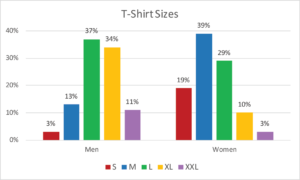One of the common things I hear with respect to Lean transformation is: “One size does not fit all.” Every organization is said to be unique, and so their Lean transformation process must reflect their situation. Even Toyota people say it is so – but, notice, without providing any details. Surely there is truth in this, right?
But, how much truth is there? Could there be less truth to “One size does not fit all” than we realize? Is it possible that people have created a convenient excuse to do less than they could otherwise do? To do what the organization will allow them to do, and not much more? To reduce the Lean transformation process to low-impact improvements that employees won’t complain about?
 “One size does not fit all” sounds to me like just another way of saying: “We’re different. This-or-that principle, method, or tool does not apply to us because we’re unique.” Uhh… no. What problem are we trying to solve? Isn’t that the question? Well, nearly everyone has the same problems: Low productivity, high costs, quality problems, over-production, under-production, and little respect for workers, suppliers, and other important stakeholders. Over 90 percent of all organizations have these same few problems to solve in their work processes.
“One size does not fit all” sounds to me like just another way of saying: “We’re different. This-or-that principle, method, or tool does not apply to us because we’re unique.” Uhh… no. What problem are we trying to solve? Isn’t that the question? Well, nearly everyone has the same problems: Low productivity, high costs, quality problems, over-production, under-production, and little respect for workers, suppliers, and other important stakeholders. Over 90 percent of all organizations have these same few problems to solve in their work processes.
The “One size does not fit all” mentality also leads people to the question of “organizational readiness” for Lean. Though one exists in a competitive business environment, “One size does not fit all” means it is acceptable to proceed more slowly because the organization “isn’t ready” – whatever that means. Note: The fact that an organization isn’t ready means IT’S FUCKING READY! AWWW! AWWW! AWWWWW! (shouted à la Sam Kinison).
If one were to visit every Toyota production facility, new and old, wouldn’t TPS appear fairly uniform in the basics? Sure, there will be some variation across the sites in different countries. But isn’t it more likely to be small than it is great? What are we to make of that?
If we say “One size does not fit all,” then that opens the door for people to re-interpret everything. Kaizen can become anything one wants it to be – or not. People could ignore kaizen because the organization “isn’t ready” or because they feel kaizen is not necessary. Instead, they can decide to spend years on 5S, value stream maps, A3 reports, and gemba walks. Tangible improvements can be made without ever coming close to continuous flow in any process. And tangible improvements can be made while ignoring the “Respect for People” principle.
The many improvements, tangible as they are, likely yield little or nothing in the way of actual productivity improvement, cost reduction, quantity control, quality control, respecting people, developing employees, and so on – even after 5 or 10 years of effort. The wide variation in methodology for Lean transformation means most organizations gain little from their efforts.
Yet, we now have books written by accomplished Lean practitioners who have had success applying Lean management to many organizations. Books such as The Lean Turnaround, by Art Byrne, and The Toyota Kaizen Continuum by John Stewart. They offer Lean transformation processes that have worked in the real world, while acknowledging some small variations may occur place-to-place. Kaizen, of course, is the heart of the Lean transformation process. As sensei Chihiro Nakao says: “When kaizen stops, everything stops.” (Read more about Toyota-style kaizen here, and click here and here for two great books on kaizen).
Do we have a situation of infinite possibilities because every organization is unique? Is that actually true? Or will a couple of methods fit most needs? In my experience, a couple of methods will fit most needs, and they parallel the methods presented in the two books previously cited. Both Art and John’s methods are derived from Toyota. The former reflects Shingijutsu’s method used when Art was president of The Wiremold Company, while the latter reflects John’s experience working at Toyota.
 The “One size does not fit all” statement reminds me of the clothing business. Specifically, making t-shirts. Clothing manufacturers do not make only one size of t-shirt for every adult human, nor do they make infinite sizes (though, now they can, despite not actually being necessary). They make a few sizes that fit nearly everyone.
The “One size does not fit all” statement reminds me of the clothing business. Specifically, making t-shirts. Clothing manufacturers do not make only one size of t-shirt for every adult human, nor do they make infinite sizes (though, now they can, despite not actually being necessary). They make a few sizes that fit nearly everyone.
The image shows the distribution of t-shirt sizes produced. Large and extra-large account for 71% of male bodies. Medium and large account for 68% of female bodies. Just two sizes fit the majority of adult male and female bodies.
My hypothesis is that there is not much Lean transformation success, and lots of Lean transformation failure, due in part due to the many varieties of methods in use, which, over time, have become ever-more infinite in number. And, these methods are also combined with other methods such as six sigma, change management, project management, DMAIC, etc., and justified by the phrase: “One size does not fit all.”
Art and John have presented standards for the beginning steps of the Lean transformation process that get you on your journey to Toyota’s production system and The Toyota Way. You can, of course, learn from them, or not. But as a Lean thinker, Job 1 is question everything: “Is it true that one size does not fit all? Maybe two sizes fit most.”
Read these related posts: What it Takes to Succeed and A Marker of Lean Success.
